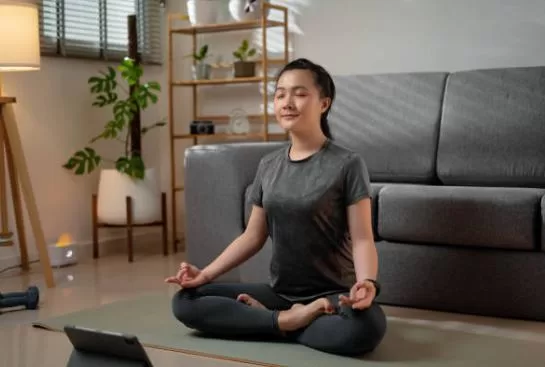How Can Visualization Be Used To Improve Stress-Related Mental Symptoms?
Visualization techniques can be a powerful tool to alleviate stress-related mental symptoms by helping individuals to focus on positive imagery and reduce negative thoughts.

Selfpause Affirmation App
Download the app to get 1,000’s of affirmation meditations and everything you need to write, record and listen to your own.
Visualization is a powerful tool that can be used to improve stress-related mental symptoms by providing a clear, visual representation of what you want to achieve in terms of stress management and mental well-being. It can help you to clearly define your goals, track your progress, and make necessary adjustments to ensure that you are on track to achieving your desired outcome.
One of the most effective ways to use visualization in stress management is to create a vision board. A vision board is a collection of images, words, and phrases that represent what you want to achieve in terms of stress management and mental well-being. These can include pictures of peaceful or happy moments, images of individuals who embody stress-free living, or quotes or affirmations that inspire and motivate you to reduce stress. By creating a vision board and placing it in a prominent location, such as your office or bedroom, you will be reminded of your stress management goals on a daily basis and be more likely to stay focused and motivated.

Another way to use visualization in stress management is through the use of mind maps. A mind map is a visual representation of ideas and information, which can be used to organize and prioritize your stress management goals. By creating a mind map, you can see the connections and relationships between different goals and determine which ones are most important. This can help you to focus on what is truly important and make sure you are making progress towards your ultimate goal.
Visualization can also be used to create a plan of action. By breaking down a goal into smaller, manageable steps, it becomes much easier to track progress and make necessary adjustments. For example, if your goal is to reduce stress, you may create a plan that includes steps such as practicing mindfulness, incorporating exercise into your daily routine, and learning stress management techniques. By visualizing this plan, you will be able to see the progress you are making and make any necessary changes to ensure that you are on track to achieving your goal.

Visualization can also be used to create a daily or weekly routine for stress management. By creating a visual representation of your daily or weekly activities that focus on reducing stress, you will be able to see how you are spending your time and make any necessary adjustments to ensure that you are making progress towards your stress management goals. For example, you may create a chart that shows how much time you are spending on stress-relieving activities, such as meditation, yoga, or journaling. By visualizing this chart, you will be able to see how you are spending your time and make any necessary adjustments to ensure that you are making progress towards your stress management goals.
Another useful technique is to use visualization to create a timeline. A timeline is a visual representation of the steps you need to take to achieve a stress management goal, along with the timeline for completing each step. By creating a timeline, you will be able to see the big picture and understand the steps you need to take to achieve your stress management goal. This can help you stay motivated and on track, as you will be able to see the progress you are making.

Visualization can also be used to track and measure your progress. By creating a visual representation of your progress, such as a graph or chart, you will be able to see how close you are to achieving your stress management goal. This can help you to stay motivated and make any necessary adjustments to your plan. For example, if your goal is to reduce stress, you may create a chart to track your stress levels over time. By visualizing this progress, you will be able to see how close you are to achieving your stress management goal and make any necessary adjustments to your actions.

In conclusion, visualization is a powerful tool that can be used to improve stress-related mental symptoms by providing a clear, visual representation of what you want to achieve in terms of stress management and mental well-being. By creating a vision board, mind map, plan of action, daily or weekly routine, timeline, or chart, you will be able to see the progress you are making and make any necessary adjustments to ensure that you are on track to achieving your desired outcome. It can help you to clearly define your goals, track your progress and make necessary adjustments to ensure that you are on track to achieving your desired outcome. It can help you to stay motivated and focused on your stress management goals, ensuring that you are able to achieve them in the end. Additionally, visualization can also be used as a tool for self-reflection in stress management, as it allows you to see your progress and identify areas where you need to improve. By using visualization to improve stress-related mental symptoms, you will be able to set clear and achievable goals, track your progress and make necessary adjustments, to ensure that you are continuously working towards managing stress and improving your mental well-being.
Our Top FAQ's
There are generally no significant risks or drawbacks to using visualization as a stress management tool. However, some people may find it difficult to focus or become frustrated if they do not experience immediate relief. Additionally, visualization should not be used as a substitute for professional medical or mental health treatment.
